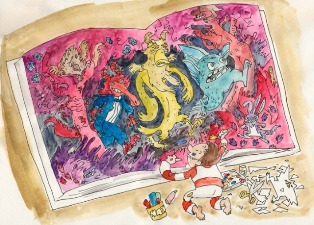
Woolf's "Wild Things" a Rumpus at CAC
If you thought Max in
Maurice Sendak's “Where the Wild Things Are” was a cutup, you should
see and hear him in the adaptation by composer Randall Woolf and German
illustrator Till Lassmann.

In collaboration with concert:nova, Cincinnati's self-described “renegade” chamber ensemble, Woolf and Lassmann loosed Max on an enthusiastic audience Thursday night at the Contemporary Arts Center.
Eleven concert:nova regulars, largely drawn from the Cincinnati Symphony and Chamber Orchestras, plus Karl Kerfoot on electric guitar, Danny Clay on sampler and Boris Buyuyildirim on electric piano, performed Woolf's 1997 ballet music in the black box Performance Space at the CAC accompanied by a slide show of Lassmann's wickedly vibrant color drawings. CSO assistant conductor Ken Lam conducted. The event coincided with the opening of an exhibit of Lassmann's “Wild Things” art in the sixth-floor UnMuseum .
Sight and sound were perfectly matched in the performance. New Yorker Woolf's 40-minute electro-acoustic score is a crazy quilt of jazz, rock, funk, gospel, even cartoon sound effects and Richard Wagner (there is a recurring “Max” leitmotif). If one wondered in advance whether viewers would miss Sendak's wolf-suited Max and his tubby monsters, any such reverence was gobbled up instantly by Lassmann's concept, which is of a slightly older Max ( maybe 9 or 10) and a truly bizarre bestiary, including an “elephant” with three eyes on its trunk and a horned red crocodile in a blue tux.
Sendak's classic 1963 children's book is about a spirited youngster (Max) who is sent to bed without supper after raising Cain throughout the house. He dreams of sailing to a mysterious island “where the wild things are” (Lassmann's is purple with a question mark on top). Max is made king and joins them in a “wild rumpus” that ends with him sending them to bed without eating. Max grows homesick, of course, and returns to his room where he finds his supper waiting for him (“still hot”).
Woolf depicts this in eight continuous movements beginning with a pounding, guitar-heavy Overture, followed by “Max misbehaves.” And does he ever, by stealing Father's matches, pounding pot lids together, terrorizing his little sister and even the family goldfish. All this flashed by in jazzy, Klezmer-tinged episodes punctuated by childish laughter and ending with a musical scolding by his parents (lots of wah-wah trumpet) and Mother's distorted voice sending Max to his room.
Heidi Yenney on acoustic violin pictured the child's mopings and imaginings in a lovely, rhythmically disjointed episode with claves and drum as the forest sprouted in his room. A gentle clarinet melody accompanied his boat ride to the mysterious island where the wild things “gnashed their terrible teeth,” etc. to some savagely sinister music (a distortion of the Max theme). Max's spoken “Now stop!” introduced a mini-jam session, ending in hymn-like fashion.
The “wild rumpus” ended in chaos as Max ordered the wild things to bed amid growls and a return of Yenney's plaintive violin as Max set sail for home. The child's dual tugs merged in a moving farewell by his fond creatures and a loving welcome by his parents as the music trailed off in fragments of keyboard.
Concert:nova continues its season in December with “Waiting for the End of Time” featuring Olivier Messiaen's “Quartet for the End of Time” and abstracts from Samuel Beckett's play “Waiting for Godot.” For information, visit www.concertnova.com.
(first published in The Cincinnati Enquirer Oct. 31, 2008)